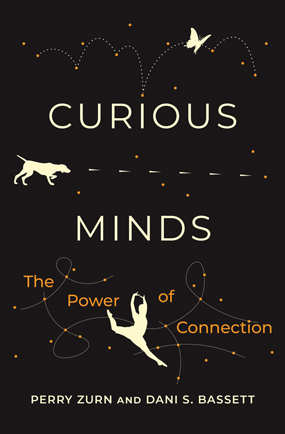
Curiosity manifests itself in, well, curious ways. Some people are like butterflies, busily collecting stories, while others are akin to hunters, methodically tracking secrets and discoveries. And still are like dancers, taking creative leaps of imagination.
In their new genre-bending book, Curious Minds: The Power of Connection, philosophy professor Perry Zurn and his identical twin, Dani S. Bassett, the J. Peter Skirkanich Professor of Bioengineering at the University of Pennsylvania, harness their respective expertise in the humanities and the sciences to get irrepressibly curious about curiosity. Traipsing across literatures of antiquity and medieval science, Victorian poetry and nature essays, and works by writers from marginalized communities, they trace a multitudinous curiosity, exploring three styles and 18 models. The book is the culmination of a seven-year collaboration between the siblings, who are extraordinarily close, sharing a private language as youngsters and publishing 23 papers together as academics. Curious Minds represents “the thought of one mind and two bodies,” they write.
The book posits that we’ve had curiosity pegged wrong for thousands of years. It’s not just the sharing of information, Zurn says, it’s the wandering tracks, the weaving concepts, the knitting of ideas, and the thatching of knowledge systems.
“Curiosity is more like a capacity to make connections. It’s wanting to connect different elements of our worlds, to connect people, and to connect ideas and concepts, aspirations, and visions,” says Zurn, an affiliate faculty in the Department of Critical Race, Gender, and Culture Studies. “Curiosity builds knowledge networks in our brains and across our societies, and to do that, you need to build connections.”
Zurn first identified the three styles of curiosity—busybody, hunter, and dancer—several years ago when he saw them surface repeatedly in the history of philosophy. Bassett—who was investigating the brain’s role in learning, using fMRI scans to show that people whose brain communication patterns exhibit more flexibility learn more the next day than people with less flexibility—noticed the same archetypes in human behaviors. That was the spark that got the twins talking about curiosity and cowriting a book about it.
Their interest in the subject can be traced back to their childhood in the foothills of the Allegheny Mountains, where their mother homeschooled them and their nine siblings from preschool through 12th grade. Growing up surrounded by natural beauty and books, they were encouraged to explore whatever piqued their interest.
“Our mom is really an artist at heart, and I think it’s her creativity that informed the way she raised us, especially the interdisciplinarity of our education. I don’t think she was ever committed to ‘this is what science really is,’ or ‘this is what writing should be,’” says Zurn, who’s teaching a seminar this spring on the philosophy of curiosity. “She was always messing with common narratives and existing value structures, and she allowed us to live in the blurry areas between things. I think that has made us far more transdisciplinary as scholars. It’s how we were introduced to what learning looks like.”
As for curiosity, it too can be learned, he says. “People often think of [it] as a personality trait—a kind of inner spark that we have, or we don’t. The more we studied curiosity, however, the more we were convinced that curiosity is something we practice. Being curious is something we do, more than something we are.”